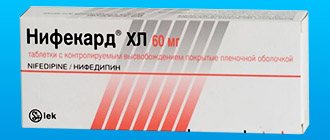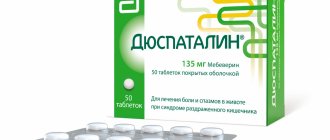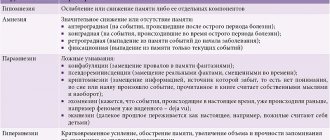Compound
Focusin includes:
- 0.4 mg tamsulosin (Tamsulosinum);
- methacrylate copolymer dispersion;
- microcrystalline cellulose;
- dibutyl sebacate;
- polysorbate 80;
- colloidal silicon dioxide , aqueous;
- talc.
Composition of the capsule shell:
- azorubine (E122);
- proprietary blue dye V (E131);
- gelatin.
pharmachologic effect
Fokusin belongs to the pharmacological group of alpha-blocker drugs, as well as to the group of drugs that influence the course of metabolic processes in the prostate gland and correct urodynamics.
The therapeutic effect of the drug is determined by the activity of its constituent tamsulosin hydrochloride , which is a white powder with a crystalline structure, poorly soluble in water, slightly soluble in glacial acetic acid and ethyl alcohol, and practically insoluble in ethers.
Pharmacodynamics and pharmacokinetics
Like other alpha-blockers , Fokusin has the ability to shield alpha receptors localized on postsynaptic membranes and respond to the action of the neurotransmitter norepinephrine , which is released from nerve endings from sympathetic postganglionic neurons , that is, efferent neurons of the autonomic nervous system that form a synapse with target organs .
tamsulosin as an active ingredient , which is a typical representative of the group of selective alpha1-blockers , and prevents the passage of vasoconstrictor impulses through adrenergic synapses, thereby provoking dilation of arterioles and precapillaries .
Another effect, which is determined by the ability of tamsulosin to competitively block alpha1A-adrenergic receptors located in the triangle zone “ prostatic part of the urethra - the lower narrowed part of the bladder (its neck) - smooth muscles of the prostate gland", as well as alpha1D-adrenergic receptors , which are localized mainly in muscle lining of the bladder ( detrusor ), is an improvement in urodynamics in prostate adenoma .
The clinical effect of taking Fokusin is observed approximately two weeks after the start of treatment. While taking the drug, patients to a significant extent:
- of the urethra increases ;
- of the bladder neck increases ;
- to the detrusor is normalized ;
- the bladder muscles improves ;
- the urethra decreases ;
- symptoms of urinary tract ;
- prostate adenoma decreases ;
- resistance to urine flow decreases;
- urination processes are normalized .
Fokusin's ability to act on alpha1A-adrenergic receptors is several times higher than its ability to interact with alpha1B-adrenergic receptors , which are located in vascular smooth muscle.
Due to such high selectivity of action, the drug does not provoke a clinically significant decrease in blood pressure . Moreover, a similar effect is observed both in patients with normal blood pressure and in patients diagnosed with arterial hypertension .
The absorption process of tamsulosin occurs in the gastrointestinal tract . The greatest absorption activity is observed when the drug is taken immediately after a meal.
The bioavailability of tamsulosin is almost 100%, and its kinetics is linear.
After a single dose of the recommended single dose of the drug, if the patient is fed, the maximum plasma concentration of tamsulosin is observed within approximately six hours.
A steady state is achieved after five days of continuous use of Focusin. At the same time, the maximum plasma concentration of tamsulosin is on average ⅔ higher than the same indicator after taking the recommended single dose.
This increase was observed in elderly patients, however, a similar effect is expected in younger people.
After oral administration, approximately 99% of tamsulosin entering the body is bound to plasma proteins , and its volume of distribution is about 0.2 l/kg and is characterized as low.
Metabolization of the substance proceeds quite slowly, and the “first pass” effect, that is, metabolism before entering the systemic circulation when passing through the wall of the gastrointestinal tract and the liver , is insignificant.
The main part of tamsulosin is found in the blood plasma unchanged, the substance is finally biotransformed in the liver .
The resulting metabolites and unchanged tamsulosin excreted in the urine .
The half-life of the substance after a single dose, if the patient is well-fed, is about 10 hours. With stable plasma concentrations of tamsulosin, its half-life increases to 13 hours.
Pharmacological properties of the drug Fokusin
Tamsulosin reduces the tone of the smooth muscles of the prostate and urethra, helps reduce obstruction, stimulates bladder emptying and significantly improves urine outflow. During treatment with tamsulosin, there is a pronounced positive dynamics of functional dysuric symptoms: a decrease in the tone of the smooth muscles of the prostate gland, bladder neck and prostatic urethra leads to a weakening of the symptoms of obstruction and irritation caused by benign prostatic hyperplasia (BPH), improved bladder emptying, reducing the volume residual urine, making urination easier. The therapeutic effect of Fokusin lasts for a long time, which makes it possible to significantly delay the need for bladder catheterization or surgical intervention. α1-blockers, by reducing peripheral vascular resistance, can cause a decrease in blood pressure. No clinically significant reduction in blood pressure was observed during tamsulosin studies. Pharmacokinetics. After oral administration, tamsulosin is quickly and almost completely absorbed from the gastrointestinal tract, its bioavailability is about 100%. Absorption is enhanced if the drug is taken immediately after a meal. The kinetics of tamsulosin is linear. When a single dose (0.4 mg) of tamsulosin is taken after a meal, the maximum concentration in the blood plasma is achieved within 6 hours. In a state of equilibrium concentration (after 5 days of continuous course administration), the maximum concentration of tamsulosin in the blood plasma is 2/3 higher than after single dose of the drug. This increase was noted in elderly patients; the same can be expected in young patients. Plasma protein binding is 99%, the volume of distribution is small and amounts to 0.2 l/kg body weight. Tamsulosin is slowly metabolized and the first-pass effect is negligible. Most of the tamsulosin is present in the blood plasma in unchanged form. Tamsulosin is metabolized in the liver. Tamsulosin and its metabolites are especially actively excreted in the urine; about 9% of the drug is excreted unchanged. The half-life for a single dose is about 10 hours. At a stable level of the substance in the blood plasma (with constant use of the drug), the half-life is about 13 hours.
Contraindications
The drug is not prescribed to the following categories of patients:
- people who have been found to be hypersensitive to tamsulosin or other substances included in Fokusin;
- people who have signs of orthostatic hypotension (including a history).
It is not recommended to prescribe Fokusin to patients with severe forms of hepatic and/or renal creatinine clearance is below 10 ml/min) failure. This is due to the lack of data on the safety of the drug in patients with similar pathologies.
Special instructions for the use of the drug Fokusin
Focusin is used with caution when performing work that requires increased concentration and speed of psychomotor reactions (driving vehicles and machinery, working at height, etc.). As with the use of other α-adrenergic receptor blockers, treatment with tamsulosin may in some cases decrease blood pressure, and loss of consciousness has occasionally been reported. When the first signs of orthostatic hypotension (dizziness, weakness) appear, the patient should be seated or laid down until the symptoms of hypotension disappear, and then blood pressure levels should be regularly monitored. Before starting to use the drug, it is necessary to verify the diagnosis in order to exclude diseases whose symptoms may be similar to those of BPH. Before starting treatment and then at certain intervals, a rectal digital examination should be performed, and, if necessary, the level of prostate-specific antigen should be monitored. The drug is used with caution in patients with severe renal failure (creatinine clearance ≤10 ml/min).
Side effects of Focusin
Like most other drugs, Fokusin in some cases can cause the development of unwanted side reactions of varying severity, which include:
- disorders of the nervous system , expressed in the form of dizziness (often), headaches (infrequently), loss of consciousness (extremely rare);
- dysfunction of the heart and vascular system (occur infrequently and are expressed in the form of symptoms of postural (orthostatic) hypotension and increased, clearly palpable heartbeat);
- dysfunction of the respiratory system , organs located in the chest and anatomical space in the middle parts of the chest cavity (the most common manifestation of this group of side effects is rhinitis);
- gastrointestinal disorders , which are expressed in the form of stool disorders, attacks of nausea and vomiting (these symptoms occur infrequently);
- dysfunction of the reproductive system , which can sometimes be expressed in the form of retrograde ejaculation (that is ejaculation characterized by the release of sperm in the opposite direction) and very rarely in the form of a prolonged painful erection not associated with sexual arousal ( priapism ).
Other side effects that have been reported while taking Focusin are infrequent asthenia , as well as constricted pupil syndrome (unstable iris). The latter can develop during cataract tamsulosin drugs for a long time .
Side effects of the drug Focusin
from the gastrointestinal tract : nausea, vomiting, diarrhea, constipation; from the cardiovascular system : orthostatic hypotension; from the central nervous system: headache, dizziness, loss of consciousness, drowsiness/insomnia; from the reproductive system : possible ejaculation disorders (retrograde ejaculation), priapism; allergic reactions : skin rash, itching, urticaria, angioedema; other: asthenia, rhinitis, back pain.
Overdose
If the permissible therapeutic dose of Fokusin is exceeded, there is a high probability of developing symptoms of acute arterial hypotension .
If this happens, to prevent further absorption of tamsulosin the patient undergoes gastric lavage, is prescribed activated charcoal or drugs similar in its mechanism of action, laxatives with osmotic properties (for example, Glauber's salt ).
While assisting him, the patient must be in a horizontal position. If necessary, he may be prescribed vasoconstrictor drugs .
In parallel with symptomatic treatment, measures are taken to provide general support to the patient’s body and constantly monitor indicators of the functional state of his kidneys .
In case of an overdose of Focusin, dialysis is not considered an appropriate procedure, since tamsulosin binds to plasma proteins .
Overdose of the drug Focusin, symptoms and treatment
There have been no reports of cases of acute drug overdose. Theoretically, the development of acute hypotension is possible, requiring measures to maintain the function of the cardiovascular system. Treatment: cardiotropic therapy, parenteral administration of volume-substituting solutions, and, if necessary, vasoconstrictor drugs. Adjuvant therapy and monitoring of renal function should be carried out. The use of hemodialysis is ineffective due to the high degree of binding of the drug to plasma proteins. In order to reduce the absorption of the drug, vomiting should be induced, gastric lavage should be performed, and the use of activated charcoal or an osmotic laxative is indicated.
Interaction
When Fokusin was taken simultaneously with the beta-blocker Atenolol , as well as the antihypertensive drugs Enalapril and Nifedipine , no drug interactions were observed.
Combined use with the antiulcer drug Cimetidine provokes an increase in plasma concentrations of tamsulosin . The opposite effect is observed when taking the drug simultaneously with the diuretic Furosemide , but this does not require adjustment of the dose of Fokusin.
Studies conducted in vitro on liver microsomal fractions related to the cytochrome P450 enzyme system showed that tamsulosin has the ability to interact with:
- tricyclic antidepressant Amitriptyline ;
- bronchodilator drug Salbutamol ;
- hypoglycemic drug Glibenclamide ;
- antitumor hormonal drug Finasteride .
The simultaneous administration of Fokusin with Diclofenac and Warfarin provokes an increase in the rate of elimination of tamsulosin .
The anxiolytic Diazepam , the beta-blocker Propranolol, the thiazide diuretic Trichlormethiazide and the hypocholesterolemic drug Simvastatin do not affect the free fraction (that is, the part that is dissolved in the aqueous phase of blood plasma ) of tamsulosin in the blood.
alpha1A -adrenergic receptor antagonist drugs can enhance the severity of the hypotensive effect .
Interactions of the drug Focusin
No interactions have been observed with the simultaneous use of Fokusin with atenolol, enalapril, nifedipine or theophylline. The simultaneous use of cimetidine leads to an increase in the plasma level of tamsulosin, and the simultaneous use of furosemide causes its decrease. At the same time, tamsulosin levels remain within normal limits, so there is no need to adjust the dose of tamsulosin. In vitro , diazepam, propranolol, trichlormethiazide, chlormadinone, amitriptyline, diclofenac, glibenclamide, simvastatin or warfarin do not change the fraction of free tamsulosin in human plasma. The drug does not affect the fractions of free diazepam, propranolol, trichloromethiazide or chlormadinone. When conducting in vitro on the microsomal fraction of the liver (to study the effect of drug metabolism on the cytochrome P450 enzyme system), no interaction with amitriptyline, salbutamol, glibenclamide and finasteriod was confirmed at the level of hepatic metabolism. Diclofenac and warfarin may increase the rate of elimination of tamsulosin. The simultaneous use of other α1A-adrenergic receptors can lead to potentiation of the hypotensive effect of the latter.
Fokusin's analogs
Level 4 ATX code matches:
Dalfaz
Sonirid Duo
Setegis
Terazosin
Sonizin
Omnik Okas
Omnic
Proflosin
Urorek
Tamsulosin
Adenorm
Omics
Fokusin analogues, which are usually understood as drugs that have the same international nonproprietary name or are equally classified in accordance with the standards of the international ATC system, are:
- Adenorm;
- Bazetam;
- Omics;
- Omnic;
- Omnimax;
- Ranoprost;
- Tamex;
- Tamsol;
- Tamsonic;
- Tamsulosin;
- Taniz;
- Tulosin;
- Urofrin;
- Flosin.
Reviews about Focusin
Many men with prostatitis or prostate adenoma are forced to take tamsulosin .
Analyzing patient reviews of Focusin, we can conclude that most of them like this drug much more than Omnic , one of its most frequently prescribed analogues.
Reviews on forums indicate that when choosing Focusin or Omnic , many prefer the first, since it is much less likely to provoke such an unpleasant phenomenon as retrograde ejaculation .
Moreover, almost all patients note a noticeable positive effect from its use: urination does not cause such problems as before the course of treatment, and the imperative urge to urinate disappears.
For some of them, the most effective is the scheme according to which Fokusin for prostatitis or prostate adenoma is prescribed after treatment with antibiotics .
Focusina price
The average price of Focusin in Russia is:
- 470-500 rubles per pack of 30 capsules;
- 1070-1200 rubles per pack of 90 capsules.
In Ukraine, the drug can be purchased at the price:
- 150-170 hryvnia for a pack of 30 capsules;
- 340-400 rubles per pack of 90 capsules.
- Online pharmacies in RussiaRussia
- Online pharmacies in UkraineUkraine
- Online pharmacies in KazakhstanKazakhstan
ZdravCity
- Focusin capsules with mod.
release 0.4 mg 30 pcs. Zentiva a.s./Saneka Pharmaceuticals a.s. 452 rub. order - Focusin capsules with mod. release 0.4 mg 90 pcs. Zentiva a.s./Saneka Pharmaceuticals a.s.
RUB 1,023 order
Pharmacy Dialogue
- Focusin (caps. 0.4 mg No. 30) Saneca
RUR 456 order
- Focusin (caps. 0.4 mg No. 90) Saneca
RUB 1,033 order
- Focusin (caps. 0.4 mg No. 30)Zentiva
476 rub. order
show more
Pharmacy24
- Focusin 0.4 mg N30 capsules AT "Saneka Pharmaceuticals", Slovak Republic/Zentiva LLC, Czech Republic
111 UAH.order - Fokusin 0.4 mg No. 90 capsules LLC Zentiva, Czech Republic/AT "Saneka Pharmaceuticals", Slovak Republic
315 UAH. order
PaniPharmacy
- Focusin capsule Focusin capsules. 0.4 mg No. 90, Saneca Pharmaceuticals
303 UAH. order
- Focusin capsule Focusin capsules. 0.4 mg No. 30, Saneca Pharmaceuticals
132 UAH order
show more


